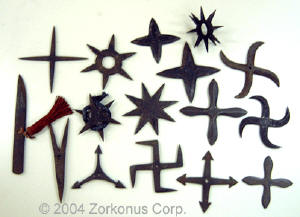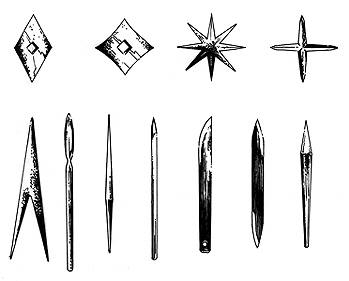| You are here: Weapons > Martial Arts Weapons > Throwing Stars > INFO |
History of Shuriken:
|
Tracing back through history to determine the origins of the ninja's unique throwing weapon is difficult if not impossible. However, there is enough information of specific shuriken designs that can be traced back to certain ninja families. For example, in theory, it can be seen how the four-pointed senban shuriken, characteristic of the Togakure ryu of ninjutsu, was perhaps developed from the four-cornered, iron reinforcing plates that backed up the heads of the spikes used in the joining of timbers in castle and fortress construction. Such blunt heavy throwing washers were known as tsubute. By heating and hammering out the four-pointed reinforcing washer, it would be possible to form a thin flat blade that could be ground at the points for sharpness. This square weapon can be used accurately up to 30 feet from the target, and can also be held in the hand for close-range fighting. The ninja's eight-pointed happo shuriken could have likewise been developed from a source totally unrelated to weapon combat. One of the nin-po mikkyo ("secret knowledge" spiritual lore) ritual implements was a wheel-like device of eight spokes, representative of the eight-fold "wheel of cosmic law." Since the true ninja families of feudal Japan saw themselves as the tools of universal law, it would be highly likely that the symbol of the rimless wheel of law could be seen as an appropriate means of accomplishing the family's aims. The hira shuriken were used primarily for wounding or harassing the enemy. The shallowness of the points usually prevented them from penetrating deeply enough to kill. However, the weapon was very effective when thrown into the hands or face of an armed pursuer by surprise. The hira shuriken could also take the role of an "invisible attacker." If a guard or enemy stood out in a cleared area, the ninja hidden in shrubs or beside a wall would throw the star blade in a spinning manner. The blades would cut the startled adversary and fly off into the grass or dirt out of sight. The bewildered victim, having been slashed by an invisible swordsman, would then take off to seek help, leaving the area unguarded. There is very little historical documentation, particularly accurate, detailed and objective information, available today on the shuriken art, due to a number of factors. Possibly the primary reason is that it was a rather secretive art... the technique of using the shuriken itself involved deception and surprise, and the main schools that utilized such methods of battle were also heavily involved in deceptive and secretive activities. What documentation that may exist would be held by the individual schools in the form of scrolls, the contents of which would only be shown to trusted students of the particular school. Today, there are many and varied types of shuriken, which suggests that the development of the art was rather fragmented and insular among various schools and areas. According to Otsuka Sensei, there were no standardized or formalized set of rules governing manufacture and use of the shuriken blades as there were with the katana, or Japanese sword, and this would have aided in the proliferation of differing designs and schools around the country. Chikatoshi Someya Sensei attempted to form some sort of categorization of shuriken in his book "Shuriken Giho", but admitted that without historical records, such categorization is purely speculative, and that there were a number of examples that could not fit in his categorization method as well. Nevertheless, such categorization can be useful today for the purpose of describing and discussing the art and the items in use. Shuriken in the 20th Century and beyond As it was an art often associated with the use of the Samurai sword, the use of shuriken declined along with that of the sword. The art seemed to have lost popularity and almost died out in the period immediately after the second world war. Many masters of the martial arts did not return from the war, as Mr Shirakami recounts, only three of master Kanji Naruse's students survived the war; Shirakami Sensei, Isamu Maeda Sensei, and Satoshi Saito Sensei, the present headmaster of Negishi Ryu. Many such arts suffered after the occupation, such as the traditional art of sword-making, but in subsequent years, as interest and understanding of Japan grew around the world, the valuable cultural heritage of this great nation began to attract many in the West, and hence a resurgence of cultural preservation has been occurring. Shirai Ryu would have died out completely were it not for Satoshi Saito Sensei resurrecting the art and incorporating it into Negishi Ryu practice, and now, students from around the world visit Japan and train in the traditional arts under these masters. Fortunately however, the art of shuriken has probably been saved by it's inclusion as a supplementary weapon within a rather large number of koryu bujutsu arts, or classical martial systems, such as Katori Shinto Ryu, Tatsumi Ryu, Yagyu Shingan Ryu, Kukishinden Ryu, etc. Due to the nature of transmission of these arts from teacher to student, or headmaster to successor, the continuation of these schools has been possible even under the most oppressive and difficult of times. However complete transmission of a schools curriculum requires many years of dedication and service, and since shuriken was considered to be of somewhat lesser importance than other weapons within the curriculum of many schools, it is probable that shuriken jutsu could continue to decline over time. Despite this, Shuriken jutsu seems to recently be undergoing somewhat of a rise in popularity. Information is becoming more freely available, and the art is being more freely taught in dojos in Japan. An example of this is in the Iwama Aikido Dojo in Ibaraki prefecture, live in students are becoming increasingly interested in the art, of which the late headmaster, Morihiro Saito Sensei was for many years a master. Entry into this particular art until recently was quite limited, students having to sign a ledger recording an oath of responsibility, and to be judged of sound character by the headmaster before being permitted to learn.
|

[an error occurred while processing this directive]
 Ninja
throwing stars are actually called shuriken. The Japanese written
characters for the word shuriken include shu (hand),
ri (release), ken (blade), for the quite literal
description of "hand released blade." Shuriken has also been
interpreted and referred to as "hand hidden blade". Historically,
there were two fundamental blade designs.
Bo shuriken were straight spike-like blades with
either one or two pointed ends, which would vary in size from short
needles to broad knives. A variation of the bo shuriken were
itaken "board blades," which were flat bars of steel with one or
two pointed ends. The second fundamental shuriken design concept,
which most people are familiar with nowadays, was the (flat)
hira shuriken, which
were thin metal plates with anywhere from three to as many as eight points
radiating out from the center. The hira shuriken were also
sometimes referred to as shaken, or "wheel blades," because
of their distinctive spoke-like shape.
Ninja
throwing stars are actually called shuriken. The Japanese written
characters for the word shuriken include shu (hand),
ri (release), ken (blade), for the quite literal
description of "hand released blade." Shuriken has also been
interpreted and referred to as "hand hidden blade". Historically,
there were two fundamental blade designs.
Bo shuriken were straight spike-like blades with
either one or two pointed ends, which would vary in size from short
needles to broad knives. A variation of the bo shuriken were
itaken "board blades," which were flat bars of steel with one or
two pointed ends. The second fundamental shuriken design concept,
which most people are familiar with nowadays, was the (flat)
hira shuriken, which
were thin metal plates with anywhere from three to as many as eight points
radiating out from the center. The hira shuriken were also
sometimes referred to as shaken, or "wheel blades," because
of their distinctive spoke-like shape.


